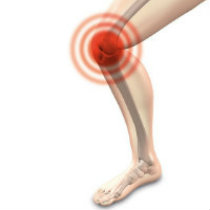What happens when you combine glucosamine with chondroitin and collagen?

This promising study showed that a daily supplement of GCQID may have positive effects on alleviating knee pain. What is GCQID you ask? It is a supplement containing 1,200 mg of glucosamine hydrochloride, 60 mg of chondroitin sulfate, 45 mg of type II collagen peptides, 90 mg of quercetin glycosides, 10 mg of imidazole peptides, 1 mg of proteoglycan, and 5 μg of vitamin D (Hence the acronym GCQID). The study lasted 16 weeks and showed that this combination of supplements may increase walking speed through increased stride length and angle of kicking from the ground during steps, which might be mainly associated with lower levels of knee pain.
The Research
Clin Interv Aging. 2016 Jun 20;11:835-41. doi: 10.2147/CIA.S103943. eCollection 2016.
Glucosamine-containing supplement improves locomotor functions in subjects with knee pain – a pilot study of gait analysis.
Kanzaki N1, Otsuka Y1, Izumo T1, Shibata H1, Nagao H2, Ogawara K3, Yamada H3, Miyazaki S3, Nakamura Y3.
- 1Institute for Health Care Science, Suntory Wellness Ltd, Seika-cho, Soraku-gun, Kyoto, Japan.
- 2Research Institute of Sports Medical Science, Tokai University, Hiratsuka, Kanagawa, Japan.
- 3School of Physical Education, Tokai University, Hiratsuka, Kanagawa, Japan.
Abstract
BACKGROUND:
Previously, we demonstrated that glucosamine-containing supplementation was effective for improving locomotor functions, especially walking speed. However, the biomechanical mechanism of efficacy has not been elucidated. This study aimed to address this challenge in subjects with knee pain, using a motion capture system.
METHODS:
An open label study was conducted in 30 Japanese subjects with knee pain. The subjects were administered a daily supplement containing 1,200 mg of glucosamine hydrochloride, 60 mg of chondroitin sulfate, 45 mg of type II collagen peptides, 90 mg of quercetin glycosides, 10 mg of imidazole peptides, 1 mg of proteoglycan, and 5 μg of vitamin D (GCQID). The intervention continued for 16 weeks. Efficacy for locomotor functions involving the knee joint was evaluated mainly using the Japanese Knee Osteoarthritis Measure (JKOM) and the 5-question Geriatric Locomotive Function Scale (GLFS-5). To examine the biomechanical mechanism of efficacy for locomotor functions, motions of subjects in a normal walking state were captured. Gait analysis was conducted and efficacy for gait parameters such as normal walking speed, stride length, cadence, and angle of soles was evaluated.
RESULTS:
GCQID significantly improved total scores on the JKOM and GLFS-5. In gait analysis, normal walking speed, stride length, and angle of soles at the end of the stance phase were all significantly increased, but cadence did not change significantly during the intervention period. There were significant intercorrelations of changes in normal walking speed, stride length, and angle of soles at the end of the stance phase, and between changes in stride length and total JKOM score.
CONCLUSION:
A GCQID supplement may increase walking speed through increased stride length and angle of kicking from the ground during steps, which might be mainly associated with alleviated knee pain.
KEYWORDS:
GLFS-5; locomotive syndrome; normal walking speed; stride length; toe angle











